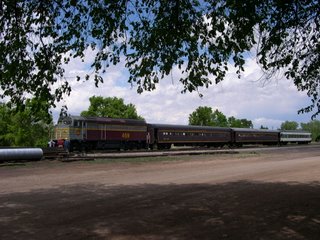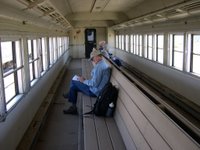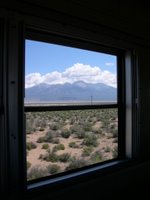
Here we are, parked maybe 75 feet from the Mississippi River between Muscatine, Iowa, and Rock Island, Illinois. Shady Creek Corps of Engineers Park has 50-amp electric hookups and large sites, many with concrete pads, and Silver Leaf Maple trees for shade. We can watch barges being pushed up and down river, as well as fishing dingys and speed boats pass by. It is a great place to spend Father’s Day weekend. And only $9 a night, since we have our National Golden Age Pass, which gives us half-price camping at all federal parks.
So far, June has been a time for family—research about family long dead and visiting with family members who are close and those we hardly know. We visited Lakin, the county seat of Kearny County in southwestern Kansas, where we learned about both scandal and success in the lives of John’s great grandparents. His great-grandmother had an affair with a nearby single homesteader that resulted in a new baby boy. A few years later, his great-grandfather was the first elected Registrar of Deeds in the county. And these grandparents separated or divorced.
Then we crossed Kansas to Olathe, where we found the graves of great, great- and great, great, great-grandparents and learned John’s family were truly Kansas pioneers, as well as “Gone to Texas Pioneers”. (Carol is from a Colorado pioneer family and probably Illinois pioneer family, as well.)
Next it was on to Boone, Iowa, for an Andrews-Whitmore family reunion. (Hazel Whitmore, Fred Andrews and Doug Andrews were sister and brothers and the parents, grandparents and great-grandparents of the 60 plus people present.)

We spent Friday through Sunday renewing relationships and getting to know relatives we’d never met. Our son, Eric, his wife, Liz, and children, Kylie, 6, and John, 11 months, joined us there. Our two families stayed at beautiful Ledges State Park south of Boone. Many of those attending the reunion stayed at the Greater Des Moines “Y” Camp north of Boone. Others came from their nearby homes.

Saturday morning a large group braved record low temperatures (for June 10) to canoe on the Des Moines River. Saturday afternoon a large part of the Colorado Andrews contingent rode the Boone and Scenic Valley Railroad. The reunion crowd at the Y Camp waved as the trained passed our meeting hall there.
After the reunion, we crossed the Mississippi River to Mercer County, Illinois, where Carol’s family has lived at least since the 1860s. There we had lunch with a cousin and his wife who live nearby. We also did family research at the county courthouse and at the Essley Noble Museum. It was back to the Iowa side of the Mississippi for the weekend, to relax and watch the birds and boats on the river. As I write, there is a Great Blue Heron standing just off shore. We drove to Burlington, Iowa, to do more research on Carol’s family. Then we head east across Illinois to Onarga to learn more about John’s family.



